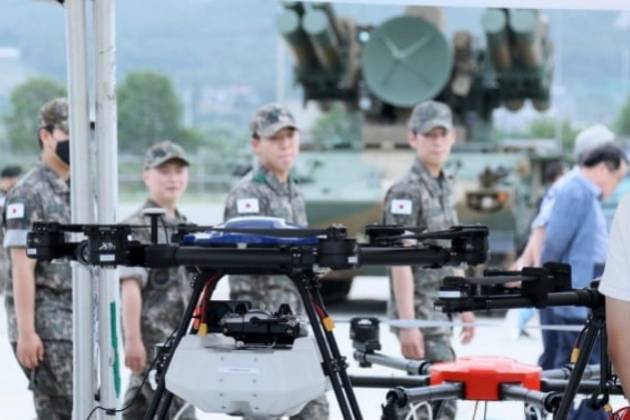Aerospace & Defense
S.Korea's top sci-tech school creates cutting-edge anti-drone technology
The system uses narrowband electromagnetic waves to prevent damage to nearby electronic devices
By Feb 01, 2023 (Gmt+09:00)
1
Min read
Most Read
LG Chem to sell water filter business to Glenwood PE for $692 million


Kyobo Life poised to buy Japan’s SBI Group-owned savings bank


KT&G eyes overseas M&A after rejecting activist fund's offer


StockX in merger talks with Naver’s online reseller Kream


Mirae Asset to be named Korea Post’s core real estate fund operator



A research team at South Korea's top science and technology university has developed an anti-drone technology that can remotely neutralize a city-infiltrating drone's circuitry by shooting narrowband electromagnetic waves.
The Korea Advanced Institute of Science and Technology (KAIST) on Tuesday said the team led by Kim Yong-dae, a professor of electrical and electronic engineering, presented this technology at the Network and Distributed System Security (NDSS) Symposium 2023, a global security forum.
Anti-drone technology uses a drone's security weak points to make it crash or control it in a desired direction.
Conventional anti-drone technology uses broadband electromagnetic waves that damage nearby electronic and electrical devices, making it difficult to use in urban areas.
The research team found that the control unit boards of drone manufacturers have varying levels of electromagnetic wave sensitivity.
Researchers analyzed the frequency that maximizes such sensitivity of each board.
This found that drones can be remotely neutralized with an extremely narrow band of "narrowband electromagnetic waves."
The team confirmed that use of an indoor facility for electromagnetic wave shielding can cause a hovering drone to instantly crash from 10 meters.
A correlation was found between attacking distance and required power, and for a distance of over 10 meters, a simulation confirmed this possibility.
The anti-drone technology is seen as useful not only in urban areas by minimizing its impact on nearby electronic devices but also in situations in which friendly drones tangle with enemy ones.
"When 100 Type A enemy drones and 100 Type B friendly drones fly at the same time, this technology prevents the latter drones from being affected at all and to shoot down all 100 enemy drones," a KAIST source said.
Write to Jin-Won Kim at jin1@hankyung.com
More to Read
-
 Aerospace & DefenseKAI to develop drone for reconnaissance, attack
Aerospace & DefenseKAI to develop drone for reconnaissance, attackDec 22, 2022 (Gmt+09:00)
1 Min read -
 Aerospace & DefenseS.Korean LIG Nex1 to develop jammers against drones from the North
Aerospace & DefenseS.Korean LIG Nex1 to develop jammers against drones from the NorthAug 22, 2022 (Gmt+09:00)
1 Min read -
 Korean startupsKorean drone manufacturer aims for 2023 Kosdaq IPO
Korean startupsKorean drone manufacturer aims for 2023 Kosdaq IPOFeb 17, 2022 (Gmt+09:00)
1 Min read
Comment 0
LOG IN


